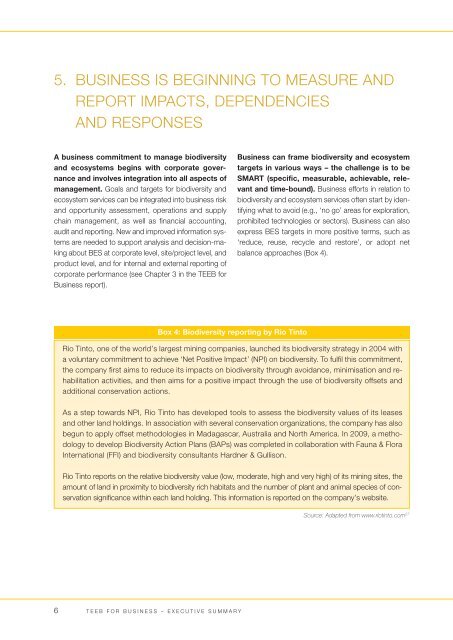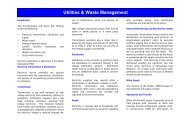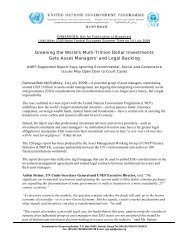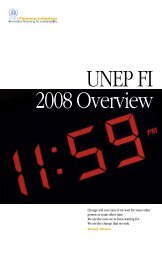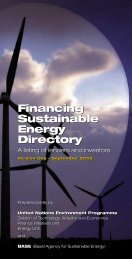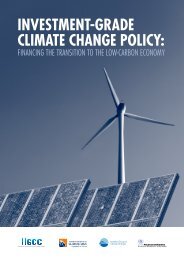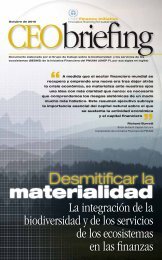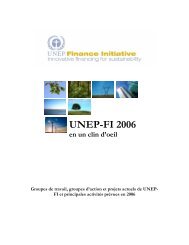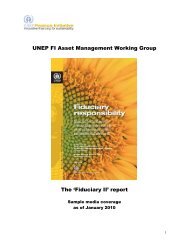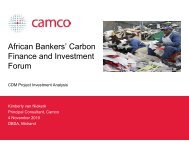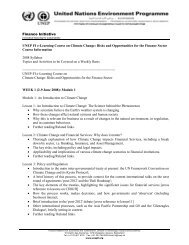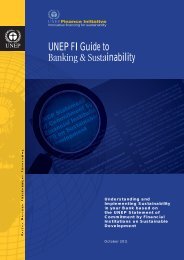for Business - TEEB
for Business - TEEB
for Business - TEEB
Create successful ePaper yourself
Turn your PDF publications into a flip-book with our unique Google optimized e-Paper software.
5. BUSINESS IS BEGINNING TO MEASURE AND<br />
REPORT IMPACTS, DEPENDENCIES<br />
AND RESPONSES<br />
A business commitment to manage biodiversity<br />
and ecosystems begins with corporate governance<br />
and involves integration into all aspects of<br />
management. Goals and targets <strong>for</strong> biodiversity and<br />
ecosystem services can be integrated into business risk<br />
and opportunity assessment, operations and supply<br />
chain management, as well as financial accounting,<br />
audit and reporting. New and improved in<strong>for</strong>mation systems<br />
are needed to support analysis and decision-making<br />
about BES at corporate level, site/project level, and<br />
product level, and <strong>for</strong> internal and external reporting of<br />
corporate per<strong>for</strong>mance (see Chapter 3 in the <strong>TEEB</strong> <strong>for</strong><br />
<strong>Business</strong> report).<br />
<strong>Business</strong> can frame biodiversity and ecosystem<br />
targets in various ways – the challenge is to be<br />
SMART (specific, measurable, achievable, relevant<br />
and time-bound). <strong>Business</strong> ef<strong>for</strong>ts in relation to<br />
biodiversity and ecosystem services often start by identifying<br />
what to avoid (e.g., ‘no go’ areas <strong>for</strong> exploration,<br />
prohibited technologies or sectors). <strong>Business</strong> can also<br />
express BES targets in more positive terms, such as<br />
‘reduce, reuse, recycle and restore’, or adopt net<br />
balance approaches (Box 4).<br />
Box 4: Biodiversity reporting by Rio Tinto<br />
Rio Tinto, one of the world’s largest mining companies, launched its biodiversity strategy in 2004 with<br />
a voluntary commitment to achieve ‘Net Positive Impact’ (NPI) on biodiversity. To fulfil this commitment,<br />
the company first aims to reduce its impacts on biodiversity through avoidance, minimisation and rehabilitation<br />
activities, and then aims <strong>for</strong> a positive impact through the use of biodiversity offsets and<br />
additional conservation actions.<br />
As a step towards NPI, Rio Tinto has developed tools to assess the biodiversity values of its leases<br />
and other land holdings. In association with several conservation organizations, the company has also<br />
begun to apply offset methodologies in Madagascar, Australia and North America. In 2009, a methodology<br />
to develop Biodiversity Action Plans (BAPs) was completed in collaboration with Fauna & Flora<br />
International (FFI) and biodiversity consultants Hardner & Gullison.<br />
Rio Tinto reports on the relative biodiversity value (low, moderate, high and very high) of its mining sites, the<br />
amount of land in proximity to biodiversity rich habitats and the number of plant and animal species of conservation<br />
significance within each land holding. This in<strong>for</strong>mation is reported on the company’s website.<br />
Source: Adapted from www.riotinto.com 27<br />
6 T E E B F O R B U S I N E S S – E X E C U T I V E S U M M A R Y


